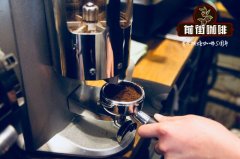Three factors that determine the flavor of coffee: raw bean quality, roasting and brewing

Professional coffee knowledge exchange More coffee bean information Please pay attention to coffee workshop (Weixin Official Accounts cafe_style)
There are three main factors that determine the flavor of coffee: green beans, roasting, and brewing. There has always been a saying in the industry: 60% of the flavor of a cup of coffee comes from raw beans, 30% from roasting, and 10% from brewing. Let's not talk about how the proportion is calculated and whether it is reasonable. However, in addition to the original flavor of raw beans, baking has a significant impact on the emphasis of flavor, which is beyond doubt.
Coffee roasting can be initially divided into five stages:
Warm-up: Preheat the coffee roaster boiler and set the temperature to the temperature at which roasting begins, known as the "bean temperature"
Dehydration period: The water content of coffee beans is usually 8-12%. Moisture is a heat conducting medium. With the increase of temperature, the free water in beans slowly evaporates, and gas is generated inside. The so-called "dehydration" does not completely remove moisture. During the baking process, moisture is also a heat conducting medium. As the temperature rises, the free water of the beans slowly evaporates, and gas is generated inside. Pressure is exerted on the tissues of the beans to promote the gradual expansion of the beans. At the same time, the beans will also change into an elastic state with changes in temperature and humidity until the water activity decreases and returns to a hard and brittle glass state. At this time, most of the cells have been converted into gas. The outer layer is also thinned by thermal expansion. Roasting too fast, bean surface and bean core moisture evaporation situation is different, easy to make coffee beans moisture uneven, resulting in skin has been vitrified, bean core is not ripe enough, and resulting in more astringent coffee.
Mena reaction period: When most of the free water is removed, the water activity drops below 0.7, and the temperature and pressure inside and outside the beans are at the same stage. At this time, the beans will expand rapidly, and the green beans will turn white and start to turn brown, and smell a bit like toast, followed by the so-called Menard reaction and caramelization stage. Mena reaction refers to a series of reactions between reducing sugars and proteins/amino acids in food when heated, resulting in brownish black macromolecules, also known as flavor compounds.
Development period: turn to a darker brown, the temperature also climbed to close to 185℃ (temperature measurement point is different, the value has deviation), you should pay attention to the upcoming cracking sound. The first explosion is the reaction of carbon dioxide and water in raw beans due to heating expansion, which is also the key point affecting flavor. After the beans begin to burst for the first time, they enter the development stage, the Mena reaction has entered the end, and the caramelization is accelerating. When the beans burst, the water vapor and carbon dioxide in the cells will be discharged in a large amount in a short time, which will cause the temperature of the beans to drop slightly and the humidity to rise rapidly. After the free water is completely released at the end of the explosion, the humidity will drop again. There are many reactions in a short time, so the air volume and fire control in the late stage of Mena reaction have a great impact on the final flavor of beans.
Chilling: When baked to the degree or temperature of your choice, the beans can be chilled. Cooling is the final key to coffee roasting. Reduce the heat of coffee as soon as possible so that the flavor of coffee can be locked in the temperature and bean condition you decide.
END
Important Notice :
前街咖啡 FrontStreet Coffee has moved to new addredd:
FrontStreet Coffee Address: 315,Donghua East Road,GuangZhou
Tel:020 38364473
- Prev

Coffee shop recommends Shanghai Xishe Coffee seesaw Cafe.
Professional coffee knowledge exchange more coffee bean information Please follow the coffee workshop (Wechat official account cafe_style) in just a few years, Seesaw coffee has spread to Beijing, Suzhou and Shenzhen, with 20 branches except Mordu's business district. Now we begin to travel abroad and participate in coffee festivals in New York, Los Angeles and other places in 2018. From 2012,
- Next

The stable product comes from the daily morning test of the coffee shop under strict control.
Professional coffee knowledge exchange more coffee bean information Please follow the coffee workshop (Wechat official account cafe_style) in the coffee culture atmosphere is getting stronger and stronger, many baristas slowly transform from a front-line position at the bar to a behind-the-scenes position in front of the roaster to roast beans, as more factors affecting the presence of coffee move forward. The baking curve of a pot of coffee often needs to enter
Related
- What documents do you need to go through to open a coffee shop? coffee shop coffee shop certificate processing process
- How to purchase Coffee beans in small Cafe how to choose a suitable supplier for domestic Coffee supply Company
- How to drink Starbucks Fragrance White Coffee? how to make Australian White Coffee? what Italian coffee beans are recommended?
- The Story of Flora Coffee: the name of Flora Coffee Bean and the implication of the Flowers on Florna Coffee
- How much does a cup of coffee cost? How much is the profit of a cup of coffee? What is the profit of the coffee shop in a year?
- Yunnan small Coffee, known as "fragrant Coffee", introduces the characteristics of Alpine Arabica Coffee producing areas in Yunnan, China
- 2023 latest Starbucks full menu price list how much is a cup of Starbucks coffee what is better to drink the most popular hot and cold drinks recommended
- Starbucks different kinds of Coffee Price list Starbucks menu 2023 Top Ten Best drinks in Starbucks
- Starbucks Spring praise Comprehensive matching Coffee Bean theme Story Packaging implication and taste description
- The cost of a cup of coffee latte American coffee cost price and selling price

